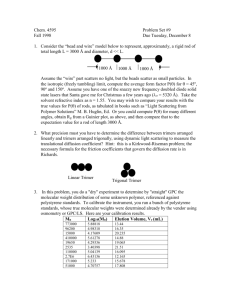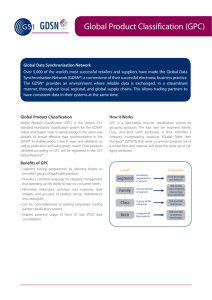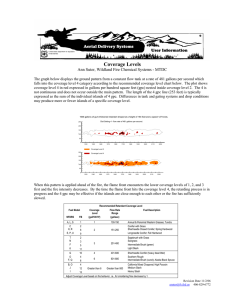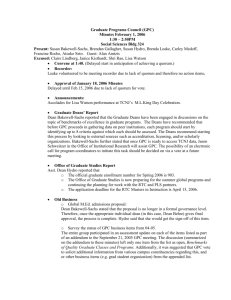AN-654 APPLICATION NOTE Optical Module Development Platform 2.5 Gbps Transmitter with Digital Diagnostics
advertisement
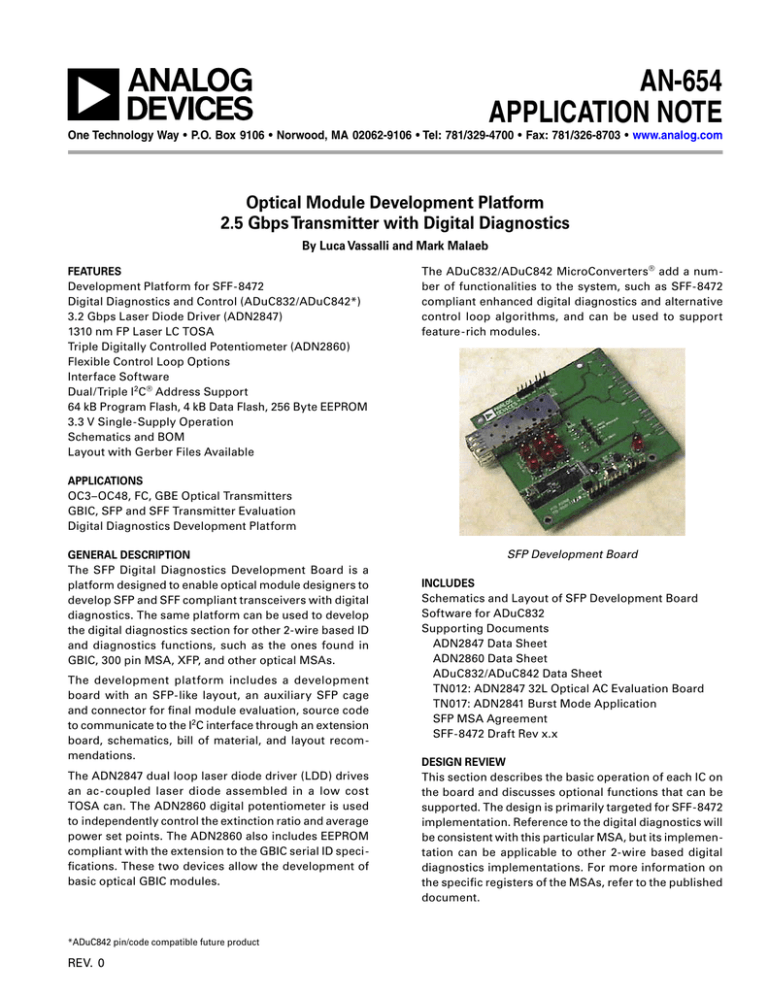
AN-654 APPLICATION NOTE One Technology Way • P.O. Box 9106 • Norwood, MA 02062-9106 • Tel: 781/329-4700 • Fax: 781/326-8703 • www.analog.com Optical Module Development Platform 2.5 Gbps Transmitter with Digital Diagnostics By Luca Vassalli and Mark Malaeb FEATURES Development Platform for SFF-8472 Digital Diagnostics and Control (ADuC832/ADuC842*) 3.2 Gbps Laser Diode Driver (ADN2847) 1310 nm FP Laser LC TOSA Triple Digitally Controlled Potentiometer (ADN2860) Flexible Control Loop Options Interface Software Dual/Triple I2C® Address Support 64 kB Program Flash, 4 kB Data Flash, 256 Byte EEPROM 3.3 V Single-Supply Operation Schematics and BOM Layout with Gerber Files Available The ADuC832/ADuC842 MicroConverters® add a number of functionalities to the system, such as SFF-8472 compliant enhanced digital diagnostics and alternative control loop algorithms, and can be used to support feature-rich modules. APPLICATIONS OC3–OC48, FC, GBE Optical Transmitters GBIC, SFP and SFF Transmitter Evaluation Digital Diagnostics Development Platform GENERAL DESCRIPTION The SFP Digital Diagnostics Development Board is a platform designed to enable optical module designers to develop SFP and SFF compliant transceivers with digital diagnostics. The same platform can be used to develop the digital diagnostics section for other 2-wire based ID and diagnostics functions, such as the ones found in GBIC, 300 pin MSA, XFP, and other optical MSAs. The development platform includes a development board with an SFP-like layout, an auxiliary SFP cage and connector for final module evaluation, source code to communicate to the I2C interface through an extension board, schematics, bill of material, and layout recommendations. The ADN2847 dual loop laser diode driver (LDD) drives an ac - coupled laser diode assembled in a low cost TOSA can. The ADN2860 digital potentiometer is used to independently control the extinction ratio and average power set points. The ADN2860 also includes EEPROM compliant with the extension to the GBIC serial ID specifications. These two devices allow the development of basic optical GBIC modules. *ADuC842 pin/code compatible future product REV. 0 SFP Development Board INCLUDES Schematics and Layout of SFP Development Board Software for ADuC832 Supporting Documents ADN2847 Data Sheet ADN2860 Data Sheet ADuC832/ADuC842 Data Sheet TN012: ADN2847 32L Optical AC Evaluation Board TN017: ADN2841 Burst Mode Application SFP MSA Agreement SFF-8472 Draft Rev x.x DESIGN REVIEW This section describes the basic operation of each IC on the board and discusses optional functions that can be supported. The design is primarily targeted for SFF-8472 implementation. Reference to the digital diagnostics will be consistent with this particular MSA, but its implementation can be applicable to other 2-wire based digital diagnostics implementations. For more information on the specific registers of the MSAs, refer to the published document. AN-654 The system as shown in Figure 1 is designed around a MicroConverter that handles both the digital interface and the analog parameters monitoring. Although a set of codes is available with this board, the design is set up to allow the user to develop their own codes and download it into the MicroConverter through either the UART or the emulator port. The design is focused on the transmitter side as most of the diagnostics is performed on or around the laser. ���� ADN2860 The ADN2860 is a low tempco 3-channel digital potentiometer (2 ¥ 512 + 1 ¥ 128 positions) with 256 bytes of user EEPROM. This device is hardwired to respond to addresses A0h and 58h. Address A0h contains the serial ID information and other static information regarding the module that the vendor specifies (Table I). This is used to support the basic GBIC requirements and the extended SFF-8472 requirements at the first 2-wire address (by default address A2 is handled by the ADuC832). ������� ����� ���� The digital potentiometer controls the extinction ratio, average power set points, and end-of-life thresholds for the laser driver (ADN2847). The potentiometer responds to I2C address 58h and is typically programmed at manufacturing to set the desired laser operating point. The RDAC values can be overwritten to RAM to adjust the laser driver settings, but typically these settings are write protected. By default, to allow the user to experiment, the ADN2860 is NOT write protected, so if these values are overwritten on the RDAC EEPROM, the original data will be lost. The code on the ADuC832 can be modified to enable this protection. ��������������� �������������� ������ ��� �������� ��� ����� ��� ���� ������� ���� ��� �� ���������� ����������� ������������ ��� �� ����������� ��������� Channel 0 controls the laser bias current threshold (failure or end-of-life indication), Channel 1 controls the average output power set point, and Channel 2 controls the extinction ratio set point. �������� ���������� ������������ For more information on register configuration for the ADN2860, refer to the device’s data sheet. The appendix lists the most useful commands. For information on the SFF-8472 register configuration, refer to the MSA document. ���� Figure 1. Block Diagram Table I. SFF-8472 Digital Diagnostics Memory Map 2-Wire Address1010000X (A0h) 2-Wire Address1010001X (A2h) 0 0 ALARM AND WARNING THRESHOLDS (56 BYTES) SERIAL ID DEFINED BY SFP MSA (96 BYTES) 55 CAL CONSTANTS (40 BYTES) 95 95 REAL TIME DIAGNOSTIC INTERFACE (24 BYTES) VENDOR SPECIFIC (32 BYTES) 119 VENDOR SPECIFIC (8 BYTES) 127 127 USER WRITABLE EEPROM (120 BYTES) RESERVED IN SFP MSA (128 BYTES) 247 VENDOR SPECIFIC (8 BYTES) 255 255 –2– REV. 0 AN-654 laser, as the driver will maintain control of ER over varying slope efficiency of the laser due to either temperature or aging effects. ADuC832/ADuC842 The MicroConverter is used to perform the monitoring and control of the key parameters in the module. The device includes an 8-channel 12-bit A/D converter, a temperature sensor, two 12-bit voltage output DACs, and an 8052 core that can operate without an external XTAL. The driver also monitors the bias current and detects failure conditions. The control loop set points are programmed on the ADN2860, while the ADuC832 reads the monitored parameters. Memory space is divided into 62K of flash program space, 4K of flash data space and 2K + 256 bytes of RAM. The MicroConverter responds to the I2C address A2h corresponding to the SFF-8472 digital diagnostics EEPROM space (Table I). The software included with the device enables an external master to read the EEPROM through the I2C interface and retrieve the relevant diagnostics information, module status, and perform software enabled functions such as software shutdown or software monitored LOS. The driver can supply up to 100 mA of bias current and 80 mA of modulation current. For more information on the ADN2847 and other parts in this family, refer to the respective data sheets and published technical notes. SOFTWARE Part of the software for the ADuC832 has been developed and is available from the authors upon request. The main functions performed by the MicroConverter are to enable the LDD, monitor the laser parameters, and communicate with an external master through the I2C. The software also includes a routine that allows the display of the requested parameter values on a PC through the RS-232 port. The monitored parameters are: VCCT, VCCR, IBIAS, IMOD, TX power, temperature, and a provision to monitor the RSSI from the receiver side of the module. They can be read through the 2-wire interface at location 96d (60h) to 119d (77h) of the A2h table. The associated alarms and warning thresholds are programmable at location 0 to 55d (37h). The flexible MicroConverter based design permits the implementation of an internally calibrated diagnostics system and does not require calibration constant to be used. The temperature sensor can also be used to perform temperature dependent compensation of the LDD settings or alarms. Following are examples of the main routines necessary to perform these tasks. Accessing the ADC and Storing Data into Memory The digital diagnostics portion of the code uses the on-board ADC to measure the module’s supply voltage, its temperature, and the LD bias current (voltage across the monitoring resistor). Output power and modulation current can also be measured but the code has not been added yet. As these values are measured they are saved into data memory space. To avoid too many memory writes, these values are stored/updated only as the request for these values is issued through the I2C. The smallest memory page size is four words. However, the software is able to update one word at a time through a software mask. The design using the ADuC842 enables both I2C addresses to be covered by the MicroConverter and in most cases eliminates the need for the ADN2860. Another advantage of using a MicroConverter based design is the ability to add additional features such as control loop and monitoring functions for APD receivers and cooled or wavelength controlled lasers. The ADuC842 is a single-cycle per instruction core and is ideal for these expanded features. Accessing the Memory Locations Through the I2C The MicroConverter is configured as a slave on the I2C bus with address A2h, as per the GBIC requirements. Data can be read from a specific address by first performing a write command to that address with no data. Next, when a read is performed, data is read from the previously set address location. ADN2847 The ADN2847 is a multirate (up to 3.2 Gbps) dual loop laser driver. It is used to directly drive an ac-coupled FP laser. The laser driver controls both the average output power and the extinction ratio over temperature and over the lifetime of the laser. This active control of both extension ratio and output power enables the module designer to cut down the time spent characterizing the REV. 0 The appendix shows the most useful commands to access the I2C interface from the external master. –3– AN-654 The EEPROMs should contain a sample of data according to the SFF-8472 standard; when the MicroConverter is enabled, it performs the digital diagnostics and other monitoring functions. The LDD performs a dual loop control function so that the board can be powered and used without downloading codes every time. Following these instructions will allow the user to transmit optical data in addition to read and write to the I2C accessible registers. SCHEMATICS AND BOM Schematics and BOM are available at the end of this document. Figure 1 shows a block diagram of the SFP TX section, while the schematics (Figures 2, 3, and 4) enable the user to develop the board. A few stuffing options are available for the user to experiment. Here is a summary of these options (Option 1 is preferred): 1. LDD set by digital potentiometer, classic configuration: Before starting, make sure you have all necessary components and equipments. Uses ADuC832, ADN2847, and ADN2860. ADN2860 controls PSET, ERSET, and ASET through R34, R35, and R36. R54 and R55 are not stuffed. R58 and R59 are not stuffed. Both ADN2860 and ADuC832 handle the I2C communication. 1. SFP Digital Diagnostics Development Board 2. 3.3 V regulated power source 3. I2C-to-PC interface board (WIN-I2CNT) available at www.demoboard.com 2. LDD set by MicroConverter: Uses ADuC842, ADN2847. ADN2860 not used. ADuC842 controls PSET and ERSET through R34 and R35. R54 and R55 are 0 W. R36 connected to ASET and GND. R58 and R59 are not stuffed. ADuC842 handles both I2C addresses. 4. PC with WIN-I2CNT board software installed. Alternatively, other I2C utilities can be used. 5. Differential signal generator (data source) set to 500 mV p-p single-ended or 1 V p-p differential 6. Optical data analyzer (optional) 3. MicroConverter forces LDD in open loop. MicroConverter handles control loop: Then proceed with the following steps: 1. Connect the WIN-I2CNT board to the PC Uses ADuC842, ADN2847. ADN2860 not used. ADuC842 controls PAVCAP and ERCAP through R58 and R59. R54 and R55 not stuffed. R34 and R35 0 W to GND, R36 connected to ASET and GND. ADuC842 sets PAV and ER based on reading of IMOD and IBIAS. These two parameters are both monitored and controlled at the same time. The dual loop functionality of the ADN2847 is disabled. ADuC842 handles both I 2 C addresses. 2. Install the I2C support software 3. With the SFP development board set to disable (JP2 and JP8 Pins 3 and 4 connected through jumper or floating), connect the 3.3 V and GND power to the SFP board (JP1) and the WIN-I2CNT board (any of the JP3, JP4, or JP5) 4. Connect the I2C interface of the development board (labeled SDA and SCL on WINI2C and SFP board) QUICK START INSTRUCTIONS A limited number of evaluation systems is available to selected customers. The schematics offered in this application note allow the user to design the board (schematics, layout, and gerber files are available upon request). Once the board is manufactured, follow these instructions: 5. Connect the data source to the development board Start with a factory preprogrammed configuration. On a blank board, download the code to the ADuC832/ADuC842. To modify the ADuC8xx code, a software update through the UART or emulator interface is necessary; QuickStart development tools for the MicroConverter are available at www.analog.com/microconverters. The board contains data on I2C addresses A2h, A0h (SFF standard registers), and 58h (ADN2860 digital potentiometer settings). For details about these registers, see the Design Review section. 6. Enable TX (JP2 Pins 2 and 3 connected through jumper) 7. Run the I2 C communication software to read and write into the EEPROM locations. See the appendix for useful commands. –4– REV. 0 AN-654 APPENDIX Most Useful ADN2860 Commands Extinction Ratio (RDAC2) I2C Address W Data Increase Resistance 2¥ Decrease Resistance 2¥ Increase One Step Decrease One Step Save Settings Read DAC Settings I2C Address R Data 58 R 7 BITS I2C Address W Data I2C Address R Data 58 58 58 58 58 58 58 58 58 58 R R 8 LSB +1 MSB RDAC0L RDAC0M RDAC1L RDAC1M RDAC2 I2C Address W Data I2C Address R Data 58 58 58 58 58 58 58 58 R 8 LSB +1 MSB 58 58 58 58 58 58 W W W W W W 9C C4 AC D4 94 04 Average Power (RDAC1) Increase Resistance 2¥ Decrease Resistance 2¥ Increase One Step Decrease One Step Save Settings MSB Save Settings LSB Read DAC Settings Read all RDAC Settings W W W W W W W W 9A C2 AA D2 92 93 02 00 End of Life Bias Current Threshold (RDAC0) Increase Resistance 2¥ Decrease Resistance 2¥ Increase One Step Decrease One Step Save Settings MSB Save Settings LSB Read DAC Settings W W W W W W W 98 C0 A8 D0 90 91 00 Most Useful Digital Diagnostic Commands Read Temperature Read VCC Read TX Bias Read TX Power Read RX Power REV. 0 I2C Address W Field I2C Address R Data A2 A2 A2 A2 A2 A2 A2 A2 A2 A2 A2 A2 A2 A2 A2 A2 A2 A2 A2 A2 MSB LSB MSB LSB MSB LSB MSB LSB MSB LSB W W W W W W W W W W 60 61 62 63 64 65 66 67 68 69 R R R R R R R R R R –5– JP1 1 2 3 4 GND 4 PIN HEADER –6– C5 0.1F L2 R18 25 3 2 1 LED C7 22F VCCR2 C8 22F 1H POWER INDUCTOR COILCRAFT 0805PS C6 0.1F D1 C2 0.1F HEADER3 JP3 C1 10F 1H POWER INDUCTOR COILCRAFT 0805PS R19 25 VCCT2 L3 VCC MOUNTING HOLE MOUNTING HOLE MH4 MOUNTING HOLE MH3 MOUNTING HOLE MH2 MH1 VCC VCC1 C3 0.1F C4 22F VCC1 3 2 1 HEADER3 JP7 VCC2 HEADER3 3 2 1 JP9 1 2 3 4 JP8 R14 10k HEADER 1 2 JP6 P4 SMA P3 SMA 4 PIN HEADER VCCT2 SW-PB SW1 R22 1k 1 2 3 4 RxD TxD RESET TX_FAULT TX_DISABLE SDA SCL MOD SEL PSEN LOS P5 SMA P2 SMA P6 SMA VCCR2 VCCT2 VCC1 P1 SMA TxD+ TxD– VCC1 JP2 4 PIN HEADER VCC1 R13 R11 R12 4.7k 4.7k 4.7k VCCT2 VCCT2 VCCT2 VCC1 HEADER4 4 3 2 1 JP4 R7 4.7k VCC1 R6 4.7k VCC1 R5 4.7k VCC1 R1 50 1H POWER INDUCTOR COILCRAFT 0805PS L1 R2 25 TxD+ TxD– RxD TxD RESET PSEN LOS TX_FAULT TX_DISABLE SDA SCL J2 FORCED LAYOUT 1 2 3 4 5 6 7 8 9 10 11 12 13 14 15 16 17 18 19 20 MOLEX SFP CONNECTOR J1 ONBOARD CONNECTOR MOLEX SFP CONNECTOR 1 2 3 4 5 6 7 8 9 10 11 12 13 14 15 16 17 18 19 20 R20 10k Q2 MAIN BOARD 2N7002 Q6 2N7002 Q5 2N7002 Q4 2N7002 Q3 2N7002 VCCT2 R15 10k Q1 2N7002 VCCT2 R8 10k VCC1 R3 10k VCC1 50 R21 50 R17 50 R16 50 R10 50 R9 50 R4 LED D7 LED D6 LED D5 LED D4 LED D3 LED D2 VCCT2 VCC1 AN-654 Figure 2. Main Board REV. 0 AGND GND LBWSET PAVCAP ERCAP TXD – TXD + LBWSET C14 1F PAVCAP TXD – TXD + C17 1F C16 0.1F C15 0.1F 17 15 16 13 12 1 CLKSEL CLK + CLK – DATA IN + DATA IN – 10 Figure 3. High Speed Section R37 1k 7 14 22 29 30 24 23 11 U3 R38 1k C20 0.01F 2 3 IMPD CCBIAS BIAS IMODP GND2 IMODN C21 0.01F IBMON IMMON IMPDMON 5 32 31 28 27 26 C13 0.1F VCCLASER 18 19 20 R34 R35 R36 1.0k 1.0k 1.0k R39 1k 6 4 L12 TOKO FSLB2520-220K 21 25 ADN2847 8 9 C18 0.01F C19 0.01F C12 0.1F IBMON ERCAP LBWSET VCC1 VCC1 TOKO FSLB2520-220K PAVCAP GND2 GND2 ERCAP IMMON VCC4 IMPDMON PSET C11 0.1F GND GND1 GND3 VCC3 ERSET L11 DEGRADE VCC1 VCC2 ASET –7– ALS REV. 0 FAIL VCC1 R32 82 DEGRADE TX_FAULT ALS IBMON IMMON IMPDMON PSET ERSET ASET R31 25 PSET ERSET ASET L13 C22 0.1F C23 10nF R40 50 MURATA BLM18AG601SN1 DEGRADE TX_FAULT ALS L14 PIN 3 TO CAN TOP SIDE OF PCB MURATA BLM18AG601SN1 R33 PIN 2 TO CAN 18 TOP SIDE LS1 DIODE_LASER PIN 4 OF TO CAN ON THE BOTTOM SIDE OF PCB AN-654 PAVCAP ERCAP ERSET PSET PAVCAP ERCAP ERSET IMMON R59 1k R57 100k R56 100k VCC LASER C51 0.1F 0.1F C52 0.1F 3 IBMON VCC1 2 IMMON DAC1 DAC0 VREF CREF AGND AGND AGND AVDD AVDD P1.3/ADC3 P1.2/ADC2 P1.1/ADC1/T2EX TxD RxD RESET P0.6/AD6 RESET P0.5/AD5 P3.0/RxD ADuC832 U2 TX_FAULT RxD TxD TX_DISABLE LOS RESET VCC1 EA DEGRADE ALS TX_FAULT TX_DISABLE LOS DEGRADE ALS 29 30 31 32 33 34 35 36 37 38 39 40 41 42 43 PSEN LBWSET SDATA P2.0/A8/A16 P2.1/A9/A17 P2.2/A10/A18 P2.3/A11/A19 EXTAL1 EXTAL2 DVDD DGND DGND P2.4/A12/A20 P2.5/A13/A21 P2.6/PWM0/A14/A22 P2.7/PWM1/A15/A23 15 16 17 18 19 20 21 22 23 24 25 26 27 28 P3.1/RxT P0.7/AD7 P1.7/ADC7 P1.4/ADC4 14 P1.5/ADC5/SS 13 12 11 C53 10 9 8 7 6 5 4 1 IMPDMON P0.4/AD4 56 55 54 53 52 51 50 49 48 47 46 45 44 DVDD P3.2/INT0 R52 100k DGND P3.3/INT1/MISQPWM1 IMPDMON IBMON R58 1k R55 1k R54 PSET 1k GND VCC1 P0.3/AD3 DVDD VCC1 LBWSET C54 CAP VCC1 DGND SDA SCL WP RE U1 ADN2860 A1R 8 A2 7 SCL SDA ERSET 9 10 11 12 W2 6 VSS 5 4 3 2 1 A0R 24 23 22 21 20 19 A0EE B2 R51 100k P0.2/AD2 DGND A1EE A1 AGND RSSIOMA RSSIOMA P0.1/AD1 P3.4/T1/CONVST ALE P3.6/WR P1.0/ADC0/T2 P1.6/ADC6 –8– SCLK P0.0/AD0 P3.5/T0/PMWC/PWM0/EXTCLK PSEN P3.7/RD NC W1 NC NC B0 WO A0 VDD NC B1 VCC1 SCL SDA ERSET ASET 13 14 15 16 17 18 ASET VCC1 AN-654 Figure 4. Control and Diagnostics REV. 0 AN-654 Table II. Bill of Materials Item Qty. Reference Description Manufacturer Mfgr P/N 1 1 C1 CAP TANT CASE-B 10 mF 6.3 V 10% KEMET T491B106K006AST 2 4 C2, C3, C5, C6 KEMET C0603C104Z4VACTU 3 3 C4, C7, C8 CAP 0603 CERM 0.1 mF Z5U 16 V +80/–20% CAP TANT CASE-B 22 mF 6.3 V 10% KEMET T491B226K006AS 4 4 C18, C19, C20, C21 5 8 6 3 C11, C13, C15, C16, C22, C51, C52, C53 C12, C14, C17 7 7 8 1 D1, D2, D3, D4, D5, D6, D7 J1 9 1 J2 10 1 JP6 CONN T.H. HEADER 2 ¥ 1 Male 0.1” SP STR Sullins Electronics PZC36DAAN 11 3 JP3, JP7, JP9 CONN T.H. HEADER 3 ¥ 1 Male 0.1” SP STR Sullins Electronics PZC36DAAN 12 4 JP1, JP2, JP4, JP8 CONN T.H. HEADER 4 ¥ 1 Male 0.1” SP STR Sullins Electronics PZC36DAAN 13 3 L1, L2, L3 Coilcraft DS1608C-102 14 15 2 2 L11, L12 L13, L14 TOKO Murata FSLB2520-220K BLM18AG601SN1 16 1 LS1 IND 1608 1 mH Power Inductor IND 1210 IND 0603 EMIFIL for DC 600 W Laserdiode T.H. 3 PINS 17 6 6 CONN T.H. SMA BNC Connector 5 PINS MOSFET SOT-23 N-CH 60 V 7.5 W LD1310-134- 4-2-C0110 SLT2276-LN SLT2276-LN SASF55ZGT-6 18 Fairchild 2N7002 19 3 P1, P2, P3, P4, P5, P6 Q1, Q2, Q3, Q4, Q5, Q6 R37, R38, R39 INFOMAX Sumitomo Excelight Lighthorse RES 0201 1 kW 1/20W 5% Panasonic ERJ-1GEJ103C 20 3 R34, R35, R36 RES 0201 1 kW 1/20W 5% Panasonic ERJ-1GEJ152C 21 1 R33 RES 0402 18 W 1/16W 5% Panasonic ERJ-2GEJ180X REV. 0 CAP 0201 CERM 0.01 mF X5R Panasonic 6.3 V 10% BC CAP 0402 CERM 0.1 mF Components Y5V 16 V +80/–20% ECJ-ZEB0J103K CAP 0603 CERM 1 mF 6.3 V X5R 10% LED T.H. Panasonic ECJ-1VB0J105K Lite-On Electronics Molex S270CKT CONN SMT SFP Connector IDC20 Forced Layout SFP Electrical Connector1 –9– Stuffing 0402F104Z160BT 74441-0010 Onboard AN-654 Table II. Bill of Materials (continued) Item 22 Qty. 1 Reference R32 Description Mfgr P/N 9C06031A82ROJLHFT RES 0201 100 kW 1/20W 5% Manufacturer Yageo America Yageo America Panasonic 23 4 R2, R18, R19, R31 RES 0603 25.5 W 1/16W 1% 24 4 25 7 26 5 27 6 28 1 R51, R52, R56, R57 R1, R4, R9, R10, R16, R17, R21 R3, R8, R14 R15, R20 R5, R6, R7, R11, R12, R13 R22 RES 0603 56 W 1/16W 5% Panasonic ERJ-3GEYJ560V RES 0603 10 kW 1/16W 1% Panasonic ERA-3YEB103V RES 0603 4.7 kW 1/16W 5% Yageo America Yageo America E-Switch 9C06031A4701JLHFT 29 1 SW1 30 1 U1 31 1 U2 32 1 U3 33 34 35 1 1 1 C54 C23 R40 SWITCH TACT 6 ¥ 3.5 MM H = 4.3 MM 130GF IC SMT LFCSP24 NV Triple Digital Potentiometer with EEPROM I2C IC SMT LFCSP56 MicroConverter with 62 kB MCU IC SMT LFCSP32 2.5 G Dual Loop Laser Driver 32 kHz Watch Crystal CAP 0201 10 nF ADI ADN2860 ADI ADUC832 ADI ADN2847 36 4 R54, R55, R58, R59 RES 0603 82 W 1/16W 5% RES 0603 1.1 kW 1/16W 5% Stuffing 9C06031A25R5FKHFT ERJ-1GEJ104C 9C06031A1101JLHFT TL1107AF130W RES 0201 50 W NI NI NI RES 0201 1 kW NI ECJ-ZEB0J103K NI = Not Installed –10– REV. 0 –11– E03716–0–7/03(0) Purchase of licensed I2C components of Analog Devices or one of its sublicensed Associated Companies conveys a license for the purchaser under the Philips I2C Patent Rights to use these components in an I2C system, provided that the system conforms to the I2C Standard Specification as defined by Philips. © 2003 Analog Devices, Inc. All rights reserved. Trademarks and registered trademarks are the property of their respective companies. –12–

